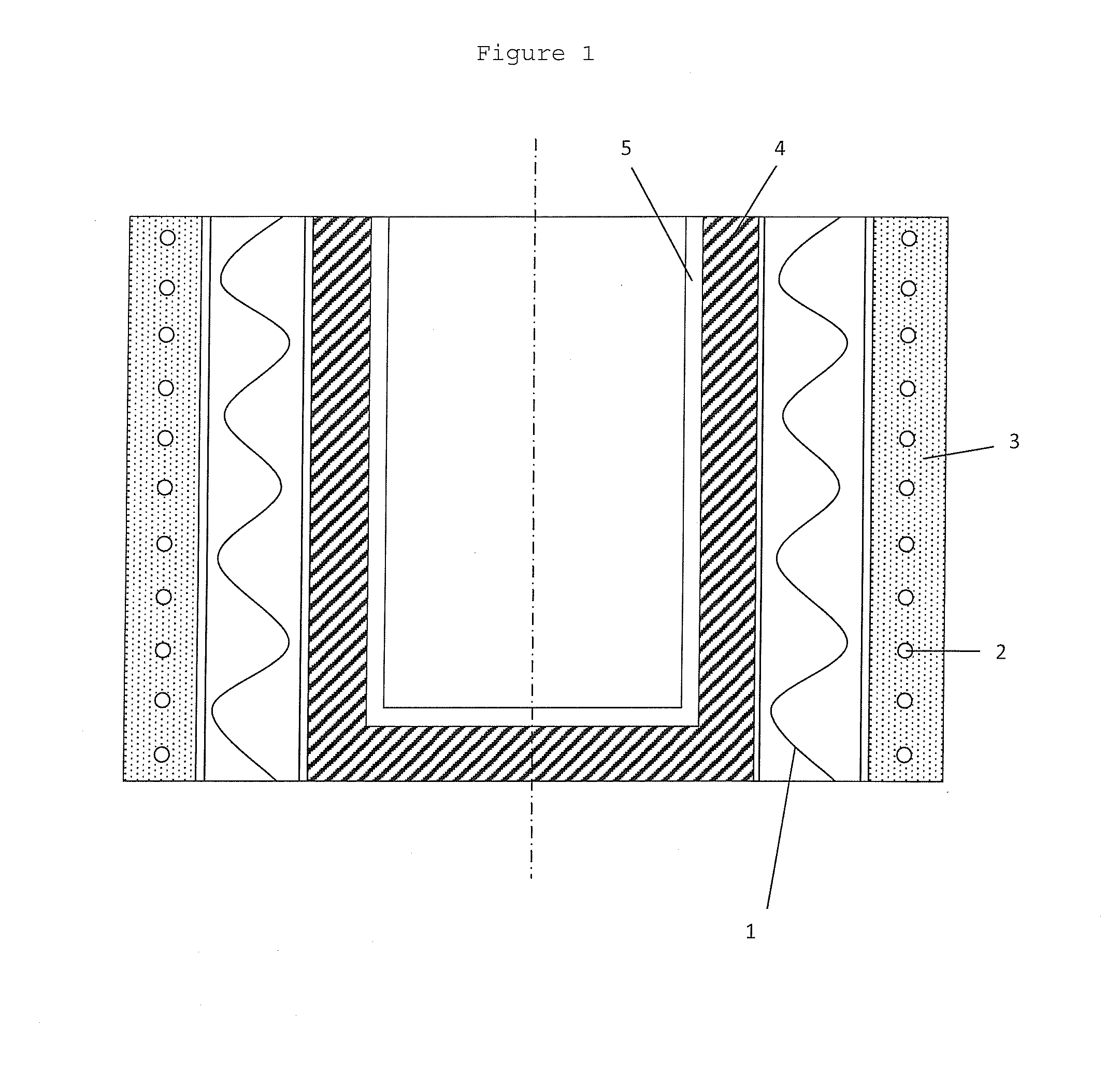Induction furnace for melting of metals, lining for an induction furnace and method for production of such lining.
a technology of induction furnace and metal melting, which is applied in the direction of furnace components, lighting and heating apparatus, household objects, etc., can solve the problems of graphite lining, graphite lining, induction coil and cooling system of lining subject to high thermal stress, etc., and achieves improved energy utilization, easy exchange, and high electrical conductivity
- Summary
- Abstract
- Description
- Claims
- Application Information
AI Technical Summary
Benefits of technology
Problems solved by technology
Method used
Image
Examples
example 1
Production of Lining in Furnace
[0070]A lining for a 75 kW induction furnace operating at a frequency of 3000 Hz was produced as follows: On the inside of the refracting layer 3 with the embedded coil 2 (FIG. 1) an insulating refractory layer 1 was cast. The insulating refractory layer 1 consisted of 96% by weight of Al2O3, the remaining being impurities such as SiO2, CaO and FeO. The thickness of the insulating refractory layer 1 was 25 mm. On the inside of the insulating refractory 1 it was tamped a lining 4 consisting of a powder mixture of 40% by weight graphite powder, 49% by weight silicon carbide and 11% by weight of silicon particles. To this mixture it was added 14.3% phenol formaldehyde resin binder based on the weight of the mixture of graphite particles, silicon carbide particles and silicon particles. To the binder it was added hexamin as a curing agent. The lining was thereafter cured and baked by placing a susceptor in a form of a graphite cylinder in the center of the...
example 2
Production of Lining Outside of Induction Furnace
[0071]The lining 4 can alternatively be made separately outside the induction furnace by tamping the lining 4 between outer and inner mould parts. After tamping, the inner mould part is removed whereafter the lining is cured. The outer mould part is thereafter removed and the cured lining is placed in a suitable furnace or heating reactor where it is baked at temperature of above 1100° C. FIG. 4 shows this embodiment providing a piston 6 used for tamping the lining 4, an inner mould part 5, and coil 7 of a furnace or heating reactor 8. The method for coating the inside of the furnace with the mixture and forming the green liner with the inner mould part 5 and piston 6 is done in a conventional manner using conventional equipment. After the lining is removed from the furnace or heating reactor 8, it is placed in the induction furnace.
example 3
[0072]The lining of Example 1 was tested for inductivity at 1000° C. At start of the supply of electric energy to the induction coil 2 the furnace took maximum effect of 75 kW at once. Thereafter solid silicon was supplied to the furnace and melted. After melting and pouring of the silicon from the furnace, the lining was allowed to be cooled to 200° C. and again tested for inductivity at maximum effect of 75 kW. The lining then took 65 kW. The effect taken by the lining was thus reduced by 15%. This shows that during curing and baking of the lining the conductivity of the lining is increased such that it connects inductively.
PUM
| Property | Measurement | Unit |
|---|---|---|
| temperature | aaaaa | aaaaa |
| length | aaaaa | aaaaa |
| particle size | aaaaa | aaaaa |
Abstract
Description
Claims
Application Information
 Login to View More
Login to View More - R&D
- Intellectual Property
- Life Sciences
- Materials
- Tech Scout
- Unparalleled Data Quality
- Higher Quality Content
- 60% Fewer Hallucinations
Browse by: Latest US Patents, China's latest patents, Technical Efficacy Thesaurus, Application Domain, Technology Topic, Popular Technical Reports.
© 2025 PatSnap. All rights reserved.Legal|Privacy policy|Modern Slavery Act Transparency Statement|Sitemap|About US| Contact US: help@patsnap.com



